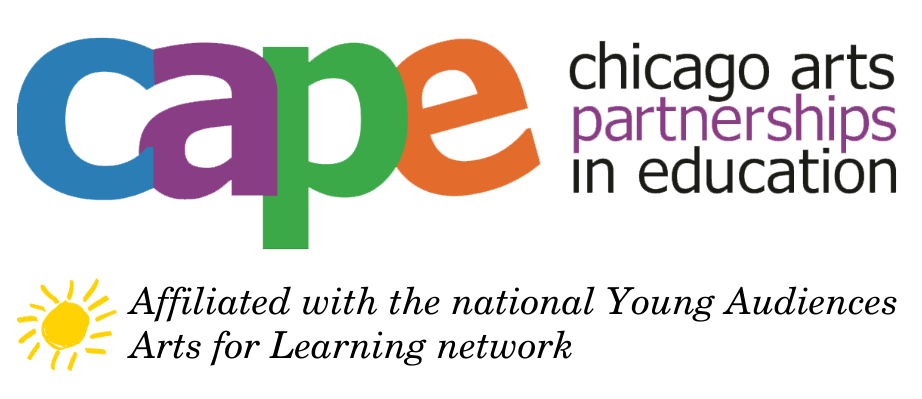5 Reasons Why We’re Still Talking About Arts Integration
CAPE staff members recently attended the American Education Research Association (AERA) Annual Meeting here in Chicago, and among the hundreds of break out sessions, we sat in on one where presenters from all over the country shared research about the positive impacts of arts integrated teaching and learning. During the Q&A portion, after all the speakers had finished their polished presentations, someone boldly asked: “Why are we still talking about arts integration?”
A silence fell over the room- the type of silence that always occurs at a conference when an otherwise cautiously polite group of adults avoiding unpleasant confrontations is disrupted by someone asking an honest and challenging question.
The questioner continued:
“We have almost two decades worth of research on arts integration that kind of says, ‘Yes, arts integration works to improve student and teacher learning outcomes,’ so… why is this even a discussion?”
The group then went on to discuss and debate the merits of arts integration- where there are gaps in the literature and possible future directions for research in this field. But for the CAPE staff members present in the room, the question resonated and lingered. In an educational climate where trends and movements garner support from above (governmental agencies school districts) and from the side (corporate & foundation funding), arts integration, which earns significant and sustained support from the grassroots (parents and educators), is often overlooked or dismissed, though it consistently returns to the table as a proven methodology that deserves a permanent seat at the table of public education.,
So, here are 5 reasons why we’re still talking about arts integration:
1. Arts Integration Creates Space for All Learners
Arts integration creates a learning space that welcomes and encourages differentiated learning. Using different art forms in the classroom creates pathways for every different type of learner– linguistic, logical-mathematical, musical, bodily-kinesthetic, spatial, interpersonal, intrapersonal, or naturalist– to receive, navigate, process, generate, and communicate academic and creative information.
2. Arts Integration Facilitates Real Dialogue Between Teachers and Students
Through arts integration, teaching and learning becomes dialogic, challenging the antiquated model of the top-down teaching hierarchy and the regurgitation of memorized facts as evidence of learning. A dialogic approach to education via arts integration means that teachers and students explore the topic they are studying by collectively researching, discussing content, creating work, and then reflecting back on that process together to generate more ideas for future work as a learning community within the classroom.
3. Arts Integration Engages Students and Teachers in the Learning Process

Put another way, arts integration is fun for students and teachers alike! Arts integration is a way of investigating ideas that is interesting to all participants—it should be as exciting for the teachers to experiment with their own teaching practice as it is for the students to learn academic content through art making. Arts integration is art, so it’s not about following a recipe or a pre-designed curriculum. Teachers are challenged to think, improvise, observe and reflect on their experimentations in arts integrated projects.
4. Arts Integration Deepens Learning Relationships
Arts integration can foster new relationships between teachers and students. Since everyone is experimenting in these projects, students get to see their teachers being vulnerable, expressive and curious; traits that are sometimes atypical in an average classroom project. This can lead to a flattening of the traditional classroom hierarchy and create the opportunity for students to step up and take on leadership roles in ways that textbooks and lectures rarely facilitate.
5. Arts Integration Builds Bridges to Parents and the Community
Arts integration can lead to deeper communications with parents and the school community- for example, in June of 2014, more than 1000 students, parents, and community members from CAPE’s Portfolio Design Project (PDP) visited the final exhibit of student art work in a professional art gallery and participated in related events. One of the participating school’s principals, Senalda Grady from Pirie Elementary, said of the show and the program,
“At the start, my students didn’t feel confident in their work or their art, but three years later, seeing all their work displayed here, they are really able to appreciate what they did. They told me, ‘I really am proud of myself, I’m more confident now,’ and they feel that they can do anything.
It is difficult to garner this type of community engagement by posting graded quizzes on the wall outside a classroom, for example. Students take on pride in sharing their artistic work in arts integrated projects, which also demonstrates their academic content learning in a way that is accessible to multiple audiences including school administrators and parents.
To find out more about CAPE’s arts integration programs and research efforts, you can join us for a one-hour info session at the CAPE office where we share more specific stories and data about the impact of arts integration in Chicago Public Schools. If you can’t make it, check out www.PAIRresults.org to learn about the impressive results of a recent CAPE study of arts integration in public school classrooms.







